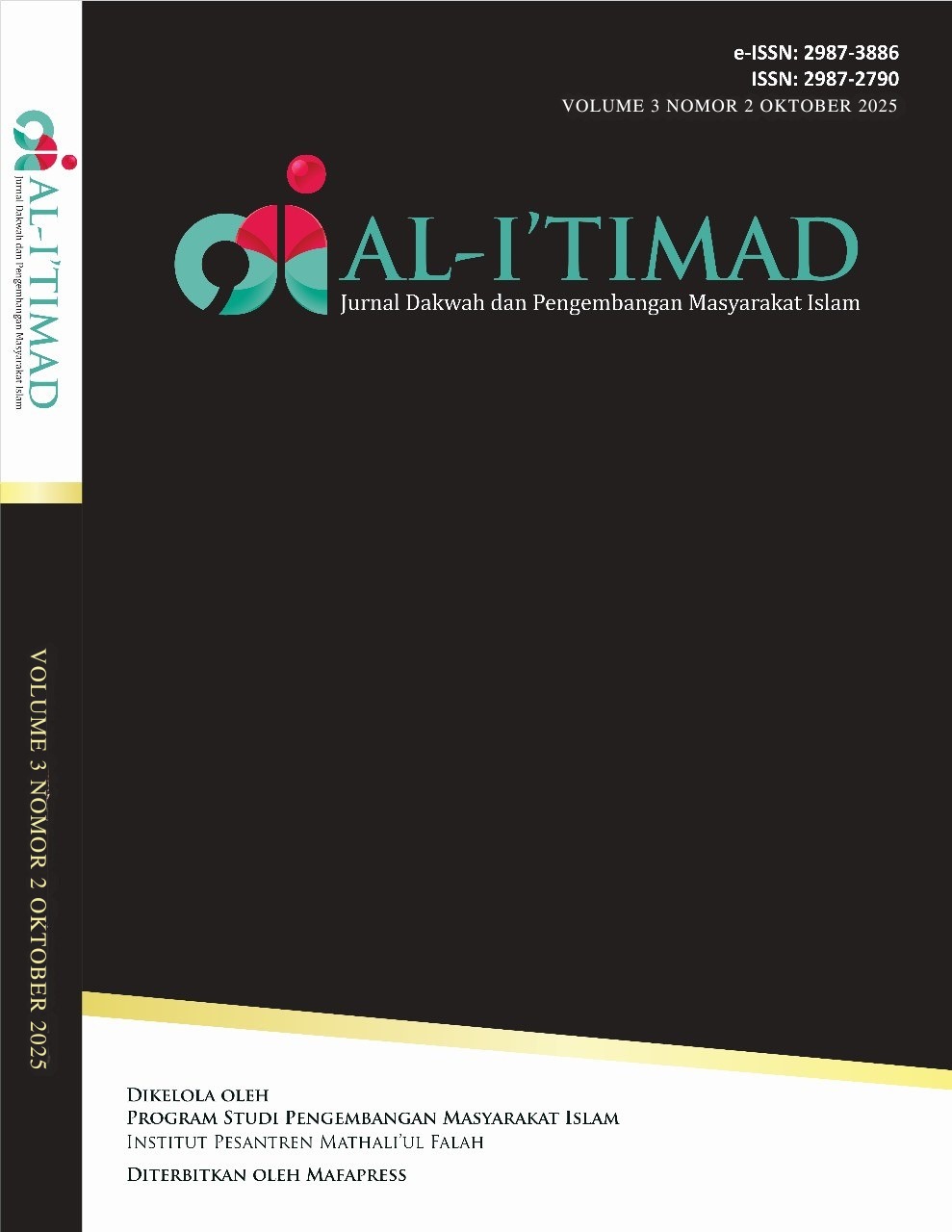Komunikasi Persuasif dalam Perspektif Hukum untuk Pengembangan Masyarakat Islam di Wilayah Kendal
Abstract
Persuasive communication is very important in shaping awareness, attitudes, and behavior, especially in the development of Islamic communities. In Kendal Regency, socio-religious life is influenced not only by culture and tradition, but also by legal regulations that govern social order. This study aims to analyze how persuasive communication from a legal perspective contributes to the sustainable empowerment of Islamic communities. Using a qualitative approach, data was obtained through in-depth interviews, participatory observation, and documentation. The results of the study show that the integration of legal values and Islamic principles strengthens social participation, increases legal awareness, and encourages the formation of an independent and empowered society. This study offers an integrative conceptual model between persuasive communication and legal legitimacy as a humanistic, adaptive, and relevant da'wah strategy in the context of Islamic society at the local level.
References
Anshori, A. (2020). Hukum Islam dan Pemberdayaan Masyarakat. UII Press.
Arifin, A. (2021). Komunikasi Persuasif dalam Dakwah Kontemporer. Prenadamedia Group.
Arifin, B. (2019). Komunikasi Dakwah: Pendekatan Persuasif dalam Penyiaran Islam. Kencana.
Cialdini, R. B. (2021). Influence: The Psychology of Persuasion (New and Expanded). Harper Business.
Effendy, O. U. (2019). Ilmu Komunikasi: Teori dan Praktek. Remaja Rosdakarya.
Fauzi, A. (2022). Zakat Produktif dan Pemberdayaan Ekonomi Umat: Studi di Lembaga Amil Zakat Jawa Tengah. Jurnal Ekonomi Syariah Indonesia, 14(2), 155–170.
Fitriani, N. (2022). Pemberdayaan Perempuan Berbasis Masjid di Era Kontemporer. Jurnal Pengembangan Masyarakat Islam, 10(1), 33–48.
Hidayat, R. (2022). Integrasi Komunikasi dan Hukum dalam Pemberdayaan Masyarakat. Pustaka Pelajar.
Ife, J. (2013). Community Development in an Uncertain World: Vision, Analysis and Practice. Cambridge University Press.
Krippendorff, K. (2004). Content Analysis: An Introduction to Its Methodology. Sage Publications.
Larson, C. U. (2013). Persuasion: Reception and Responsibility (13th ed.). Wadsworth Cengage Learning.
Lubis, A. (2023). Ethics and Regulation of Islamic Digital Communication. Indonesian Journal of Media and Society, 8(1), 45–60.
Marzuki, P. M. (2019). Pengantar Ilmu Hukum. Kencana.
Miles, M. B., & Huberman, A. M. (2014). Qualitative Data Analysis: A Methods Sourcebook (3rd ed.). Sage Publications.
Moleong, L. J. (2018). Metodologi Penelitian Kualitatif (38th ed.). PT Remaja Rosdakarya.
Nasution, I. (2021). Persuasive Communication and Legal Awareness in Islamic Preaching. Jurnal Dakwah Dan Komunikasi Islam, 12(1), 23–39.
Patton, M. Q. (2015). Qualitative Research & Evaluation Methods: Integrating Theory and Practice (4th ed.). Sage Publications.
Perloff, R. M. (2017). The Dynamics of Persuasion: Communication and Attitudes in the 21st Century (6th ed.). Routledge.
Rahardjo, S. (2020). Hukum dan Masyarakat. Gadjah Mada University Press.
Sugiyono, & Nuryanto, A. (2019). Metode Penelitian Pendidikan (kuantitatif, kualitatif, kombinasi, R&D dan penelitian tindakan) (E. 3. C. 1. (ed.)). Alfabeta.

This work is licensed under a Creative Commons Attribution-ShareAlike 4.0 International License.












